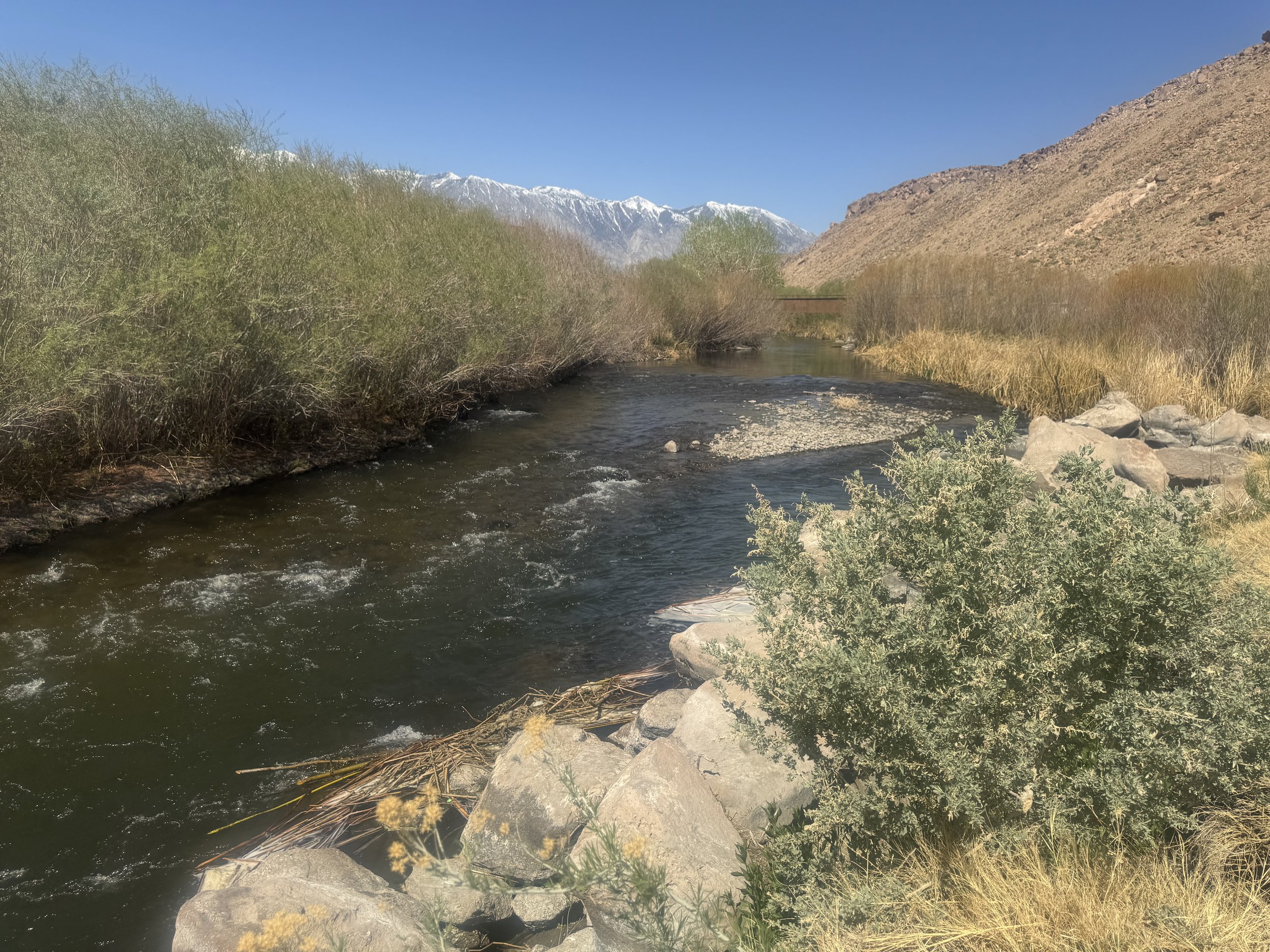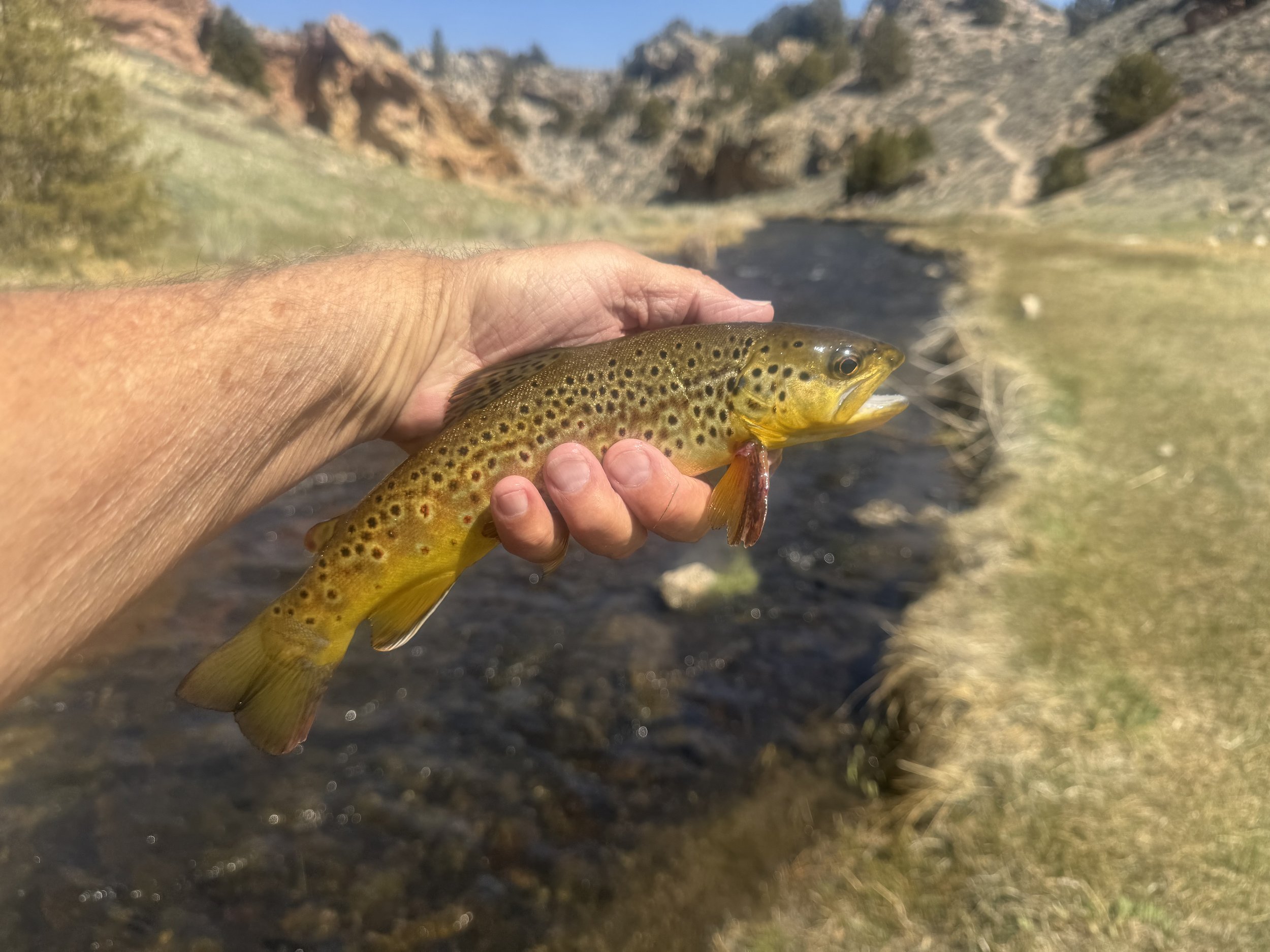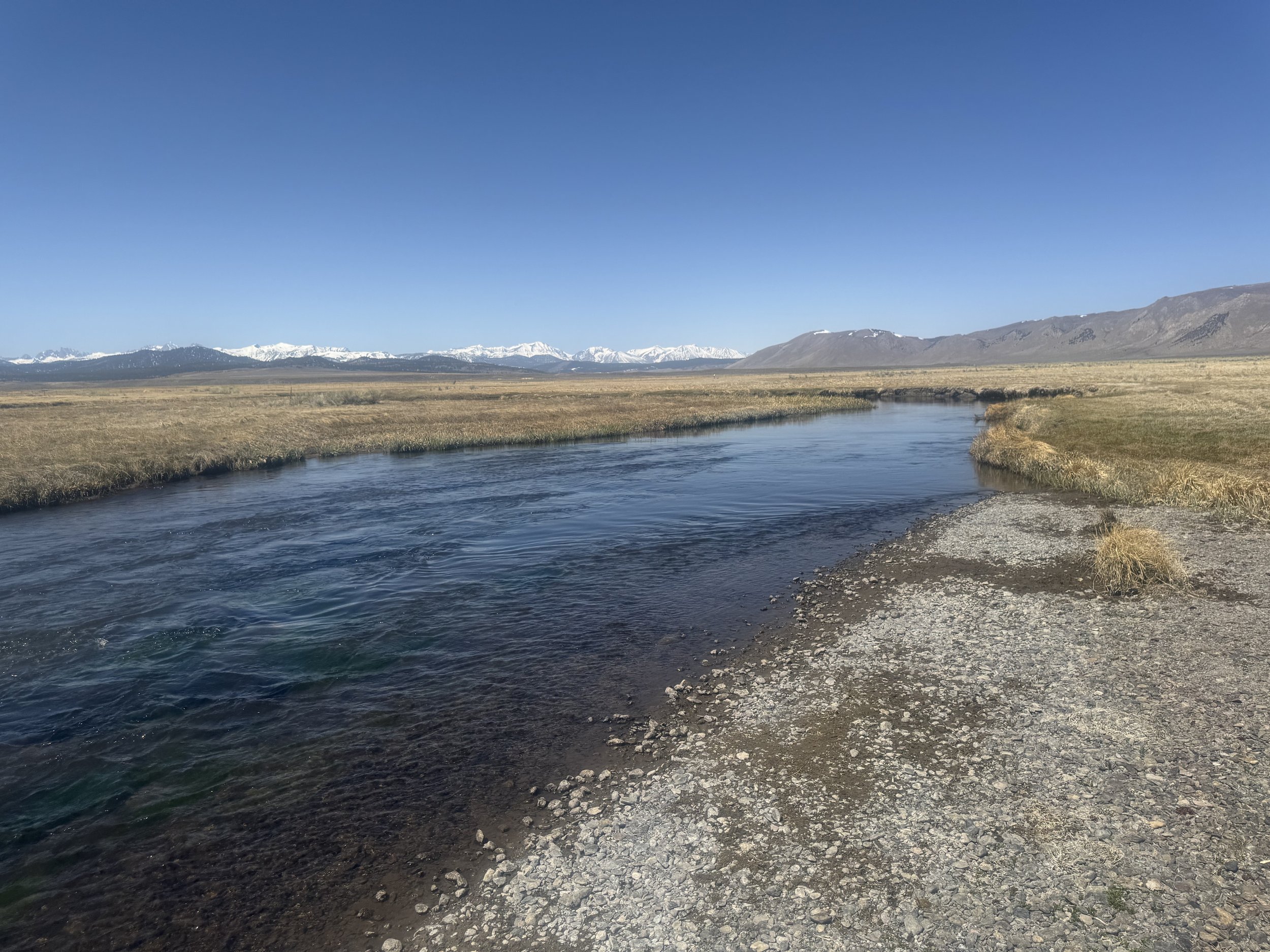We have what I consider a Fall weather pattern this spring in the Owens Valley. Heater in the morning. Air conditioner middle of the day. Heater in the evening if I’m cold. Air condition in the evening if I’m hot. This warm weather trend is melting snow at upper elevations pretty quick. Is spring runoff right around the corner? Depends on whether spring is cold or hot. April and May are quite often cold and windy prolonging spring runoff tell late May or early June. The increase in sun light per day is activating the aquatic insects. Midges, mayflies and caddisflies are hatching and feeding the trout in lakes and streams. Most consistent way to catch trout right now is to nymph fish under a dry fly, with an indicator or with a Euro rig.
The Silver Fire is 100% contained and has opened up some of the lower Owens River upstream of HWY 6.
Lower Owens River
Wild Trout Section:
Flows are fluctuating from the high 70 CFS to the high 90 CFS. Flows are expected to be around 100 CFS through the end of April. Flows will increase in May when DWP starts shipping water south to fill up reservoirs for summer water use in Los Angeles. Nymphing continues to be the most productive method of fly fishing the wild trout section of the lower Owens River. Nymphing under an indicator or with a Euro rig is the best way to present you nymphs to the trout feeding on the substrate. Use size 18 olive quilldigons, size 18 bead head flash back pheasant tail nymphs, size 18 gasolina nymphs, size 18 SOS nymph and size 20 midges in blood, zebra and tiger coloration to fool the larvae feeding trout. On the surface if you are on the right hole on the right day a size 18 Adams parachute, size 18 olive sparkle dun, size 18 blue wing olive parachute and a size 18 elk hair caddis will fool the surface feeding wild trout. To stay up with the changing flows check out Eastern Sierra water flows on my webpage at https://www.sierrabrightdot.com/water-flows-owens-river-east-walker-river.
Lower Owens River flows are going to hover around 100 CFS through April and then will go up as DWP moves water out of Crowley Lake to make room for this seasons snow melt.
Hot Creek
Interpretive Site:
The Interpretive Site offers easy access to a ¼ mile section of Hot Creek between Hot Creek Hatchery and Hot Creek Ranch. This site is getting more fly fishing pressure with its easy access to the water. The mid-day hatch of midges is impossible to imitate with a single midge pattern because they do not make a hook small enough to imitate the tiny size of the natural midges. The solution is to dry fly fish with a pattern that imitates a cluster of midges like the Griffiths gnat in size 20 to 24. Size 24’s are hard to see on the water. The solution is to fish with a dry and dry fly rig. Tie on a size 16 Adams parachute, size 12 Chernobyl ant or size 14 stimulator and attach three feet of 5X or 6X monofilament tippet with a clinch knot to the bend of the hook of the large dry fly. Any movement in the larger dry fly or any rises within three feet of the big dry fly set the hook. There are hatching blue wing olive mayflies mixed in with the midge hatch. Fish with size 20 blue wing olive parachutes, size 20 Adams parachutes and size 20 olive sparkle duns. Nymphing with size 20 blood midges, zebra midges and tiger midges, size 18 olive quilldigons, size 18 SOS nymphs and size 18 bead head flash back pheasant tail nymphs continues to produce trout in the Interpretive site of Hot Creek.
Eight to 12 inch brown trout are taking nymphs and dry flies delivered by fly fishers fishing in the Canyon Section of Hot Creek.
Hot Creek
Canyon Section:
There has been little to no fly fishing pressure in the canyon section of Hot Creek. Will the word is out that Hot Creek Canyon is fishing good and there is now a crowd of fly fishers taking advantage of the nymph and dry fly feeding trout. Nymphing before the hatch is producing wild brown trout and rainbow trout. Use size 18 Jedi Master Baetis, size 18 bead head flash back pheasant tail nymphs, size 18 SOS nymphs, size 18 gasolina nymphs, size 20 soft hackle brassies, size 20 zebra midges, size 20 blood midges and size 20 tiger midges to fool wild brown trout and rainbow trout to 14 inches. The mid-day midge hatch has a few blue wing olive mayflies sprinkled into the hatch. For the dry fly enthusiast use size 20 blue wing olive parachutes, size 20 Adams parachutes and size 20 to 24 Griffiths gnats. Carry a few size 20 gray bodied caddis dry flies to fool the trout during the sporadic caddis hatch.
The upper Owens River is in perfect shape for fly fishers looking to catch eight to 12 inch wild rainbow and brown trout.
Upper Owens River
Above Benton Crossing Bridge:
The trophy rainbow trout season is over for the year. The trophy cutthroat migration will start in late April or early May. The peak of the cutthroat run is sometime between the 10th to 20th of May. The run is pretty much over by Memorial day weekend. Sierra Bright Dot guides still have openings for fly fishers wanting to catch a trophy cutthroat trout. Fly fishers are targeting the six to 12 inch resident browns and rainbows with nymphs and dries mid-day. For the nymphs fish with size 18 bead head flash back pheasant tail nymphs, size 18 olive quilldigons, size 16 gold ribbed hare’s ears, size 18 blood midges, size 18 tiger midges and size 18 zebra midges. For the dries fish with size 18 elk hair caddis, size 18 Adams parachutes, size 18 blue wing olive parachutes and size 18 olive sparkle duns.
A typical wild brown trout that was fooled by a size 18 olive quilldigon fished on a three fly euro rig in Bishop Creek Canal.
Bishop Creek Canal
Behind Bishop Veterinary Hospital:
Increased sunlight during the day has the wild brown trout and hold over rainbows feeding on nymphs in the deeper holes and riffle sections. Euro nymphing with a size 18 olive quilldigon, size 18 bead head flash back pheasant tail nymph, size 16 SOS nymph and size 20 tiger and zebra midges are fooling the trout. For an indicator rig place the indicator 1.5 to 2 times the average depth of water above the bottom nymph. Use split shot to get your nymphs down on the substrate where the trout are feeding. Right now a size 1 split shot is the right amount of weight. Trout are still spooky and fly fishers should sneak up on the water to keep from spooking the trout.





